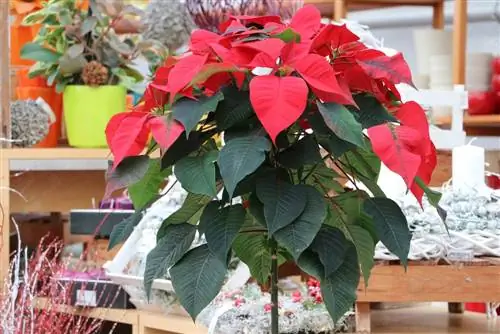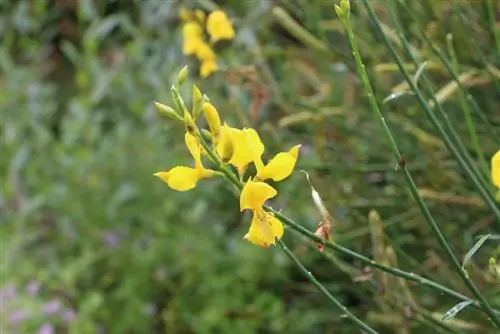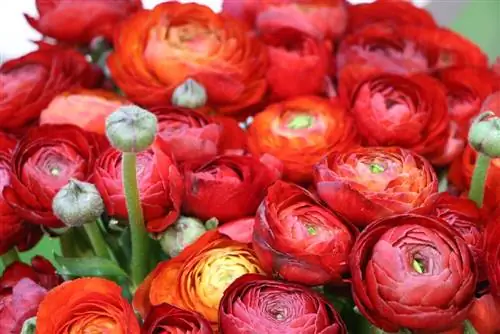- Author admin [email protected].
- Public 2023-12-17 03:39.
- Last modified 2025-01-24 12:45.
The homeland of the black-eyed Susan is southeast Africa. This also explains why the climbing plant is not hardy and is extremely sensitive to cold temperatures. It can be damaged even at temperatures of around plus five degrees Celsius. To prevent things from getting that far, you should put Thunbergia alata aside when nighttime temperatures drop below plus ten degrees Celsius in autumn.
Overwintering in winter quarters
Since the black-eyed Susan can only overwinter indoors, the choice of winter quarters is important because it shouldn't be too cold there, but shouldn't be too warm either. Optimal conditions for overwintering are:
- Temperatures between plus seven and ten degrees Celsius
- Brightness
For example, this is suitable as winter quarters:
- a winter garden
- a cellar with a window
- a bright staircase
When the time comes to move to winter quarters, the plant doesn't need much preparation. It is ideal if you cut Thunbergia alata back to around 50 centimeters before moving. This not only saves space in the winter quarters, but also helps the plant survive the cold season better. You should also remove all dried and yellow leaves.
Tip:
Also check the plant for pests and diseases. If you find diseased or pest-infested areas, cut them off generously.
Care in winter
The time of overwintering is a time of rest for the plant, as constant growth or flowers are not desired during this time. In order for the black-eyed Susan to recognize or “maintain” the resting phase, care must be reduced.
Pouring
Thunbergia alata cannot survive overwintering without watering. It is best to water the climbing plant moderately so that it does not dry out completely. The following applies here: Less is more.
Fertilize
Fertilization is not carried out during wintering.
ventilate
The black-eyed Susan doesn't like winter quarters with bad or stale air. That's why the winter quarters also need to be ventilated regularly. Since the plant is not winter hardy, you must pay attention to the outside temperatures when ventilating. Ideally, there is short but intensive ventilation on frost-free, warmer days.
Tip:
So that the fresh cold air does not harm the plant, you should, if possible, not place the black-eyed Susan directly by the window.
Pest Infestation
Since pests particularly like to nest when plants overwinter, you should regularly inspect the black-eyed Susan for pest infestation. If an infestation is discovered, you should cut off the affected areas so that the infestation cannot spread further.
After wintering

Preparations for the outdoor season begin very early for Black-Eyed Susanne. Because it should be placed indoors in February in a warm and sunny place to get used to the sun. Make sure that Thunbergia alata is protected from the midday sun, as it cannot tolerate it at this point.
Thunbergia alata is only allowed outside during this time if it is given a sunny and protected location and the temperatures are at least eight Celsius, because it is not hardy. Since this often only works for a few hours, you should only put the plant outside if it gets a location in front of the balcony or patio door. The plant doesn't like going back and forth between different locations. You can also prune the Black-Eyed Susan at this time.
If the plant begins to awaken from hibernation, you should also increase the care measures and give it more water, i.e. water it regularly. In addition, the time for fertilization also begins in this transition phase.
Tip:
If the climbing aid has fallen victim to the move to winter quarters, then it should be reinstalled now.
Relocation to the open air
The final move outside, be it on the balcony, terrace or garden, will not take place until mid-May at the earliest, after the Ice Saints, because then the time of cool nights (=below ten degrees Celsius) should be over. The Black-Eyed Susan can only move to its final summer location once it has gotten used to the sun outside. Therefore, you should choose a warm but cloudy day for the move. You should also place the plant in a sun-protected place for the first few days so that it can get used to the sun's rays. If it immediately feels the full sun, its leaves will burn, as plants can also get sunburned.
Tip:
If there is a cold snap in the summer, you should bring the plant indoors at short notice.
Conclusion
The black-eyed Susan is not particularly hardy, but overwintering is possible with the right care and so the Thunbergia alata can also bloom for several years.






